
 |
This window was commissioned by the Unitarian Universalist Church of Arlington, Virginia, to compliment the new Celebration Hall they had built. With beautiful German glass, hand-ground accent bevels, and beautiful custom metal work, this stunning window brings the room to life with its richness.
You can explore this project more in-depth on our Facebook page. . |
 |

This window was created using our 1915 Henry Lang machinery. We glue chipped 1/4″ glass for the background first, always making at least three times as much as we needed so we could select for the effect we wanted. Here we were searching for a natural frost look to contrast the border. By hand beveling various thicknesses of glass over rotating iron, stone, cork, and felt, we were able to bring the beveled edges to life with many small facets. The opening for this window was an interior wall, so to get our art piece to life, we hung a chandelier behind it. The light from the many small bulbs reflecting off the bevels is stunning as one moves around the sanctuary. As one member called it, “Our Spiritual Window.”
Richmond Times Dispatch:
November 1996 (.pdf | .jpg)
 |
Removing faded and yellowing plastic coverings and replacing them with clear tempered or safety glass with proper venting systems is an important part of what we do to preserve the integrity of our clients architecture. |

These wonderful windows were hidden under over a hundred years of filth, covered up so that no light was able to shine through them at all. Many of the more than thirty panels were in severe disrepair as well, bowing, with cracked glass and missing pieces, broken lead joints, and non-existent putty. While the hotel was being restored to welcome the Attorney General, we removed all of the windows and transported them to our studio where we completely restored them over many months. After the building renovation, the windows once again had light shining through them, and they brought the foyer alive. We were very honored to work on this project in tandem with Kjellstrom and Lee Construction, to help with the restoration of the historic Hotel Richmond.
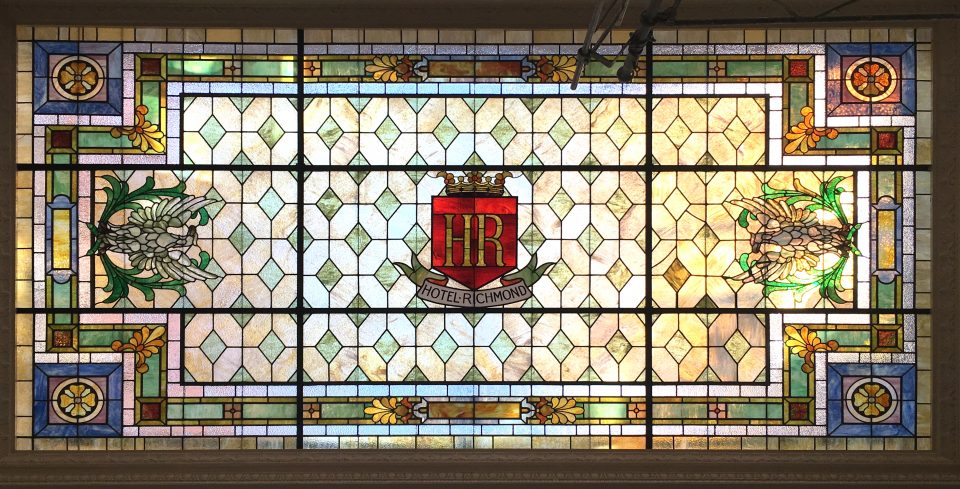
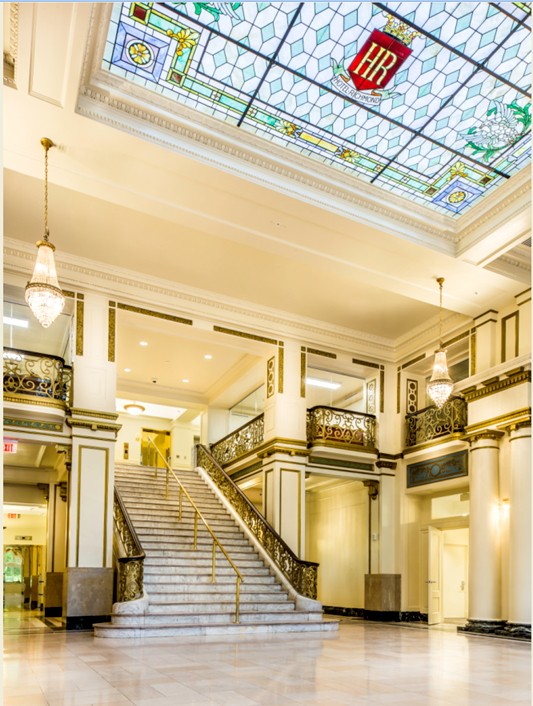 |
 |
|
The finished Hotel foyer with the windows. |
A look from above. |

The three windows before restoration.
 |
|
 |
 |
| This excellent window is a lovely example of how glass can uniquely capture nature’s movement and beauty. The dogwood blossoms and leaves against the interweaving sculpted solder branches bring this piece to life. The flameworked flowers and leaves free us from traditional lead lines, allowing us to explore the playfulness and spontaneity of a natural tree.
If you’d like to see more about the creation of this window, please visit our Facebook page. |
|
 |
|
| This beautiful home on Monument Avenue in Richmond, Virginia was undergoing a complete restoration by Dovetail Construction, and this included the century-old beveled glass windows throughout the house. The beveled glass was removed and transported to our studio, where we carefully replaced any broken or cracked bevels with matching ones hand-ground on our antique Henry Lang machinery. We also restored the landing window, which was a beautiful trellis scene with vines and morning glories. These windows now shine again with their original brilliance, and are the highlight of the home. | |
 |
|
 |
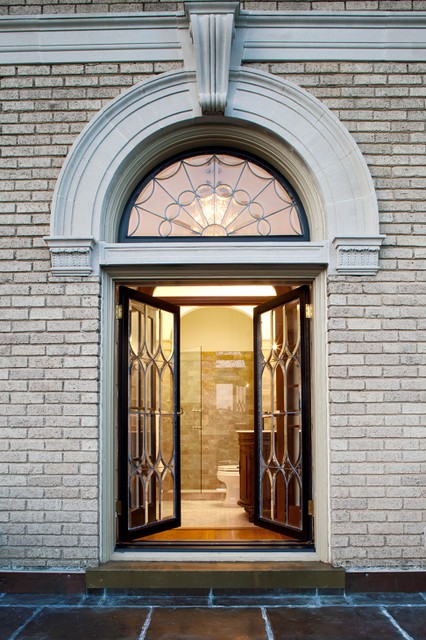 |
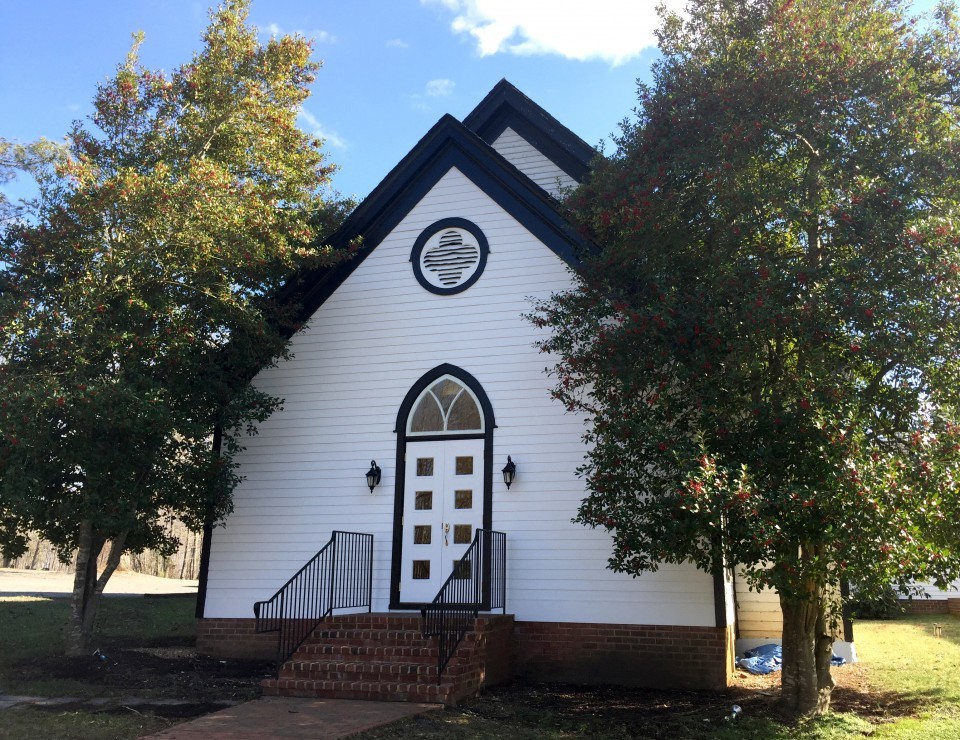 |
|
| This beautiful country church has been standing since 1852, and churches of this age all begin to suffer from the same maladies; slate roofs leak, stained glass repairs need to be made. We installed new 1/4″ clear tempered glass protective coverings, properly vented. We also repainted the window frames and sills, and fixed a few broken pieces of slate while we were there. | 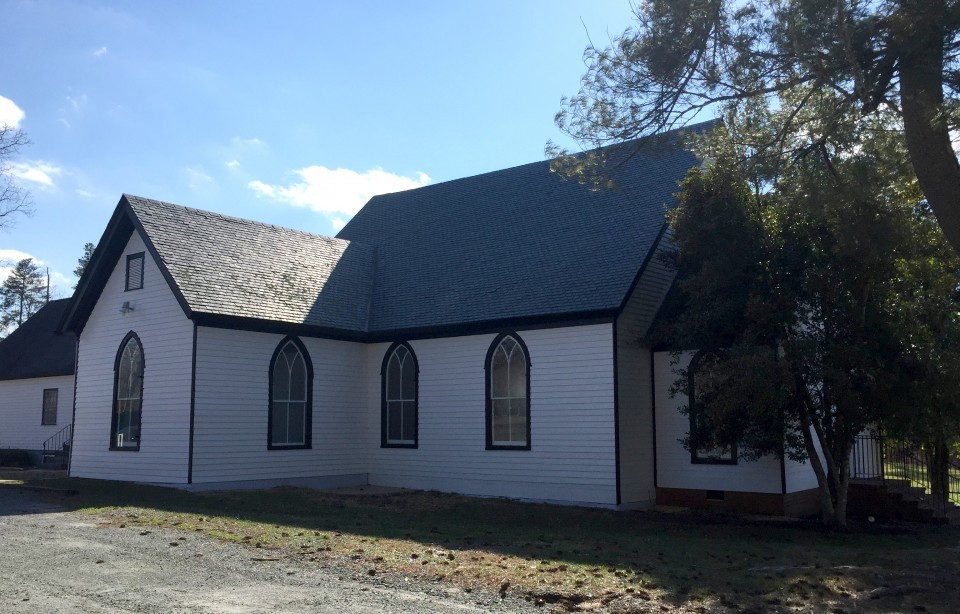 |
 |
|
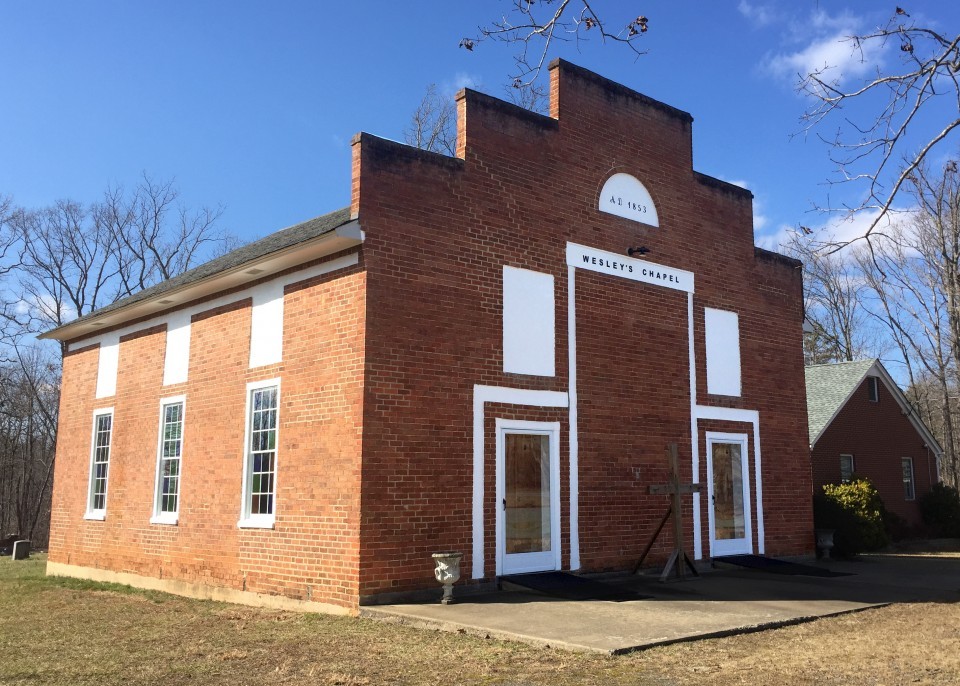 |
|
|
This lovely little chapel in rural Fluvanna County, Virginia was in need of some attention. Having been around for over 150 years, many of the old repairs and elements of the church were deteriorating. We invest so much effort in keeping these small church as unique and authentic as when they were first constructed. We repaired the slate roof, installed new copper flashing to the brick facade, repainted the entrance lettering, as well as installed protective coverings made of non-yellowing tempered glass. |
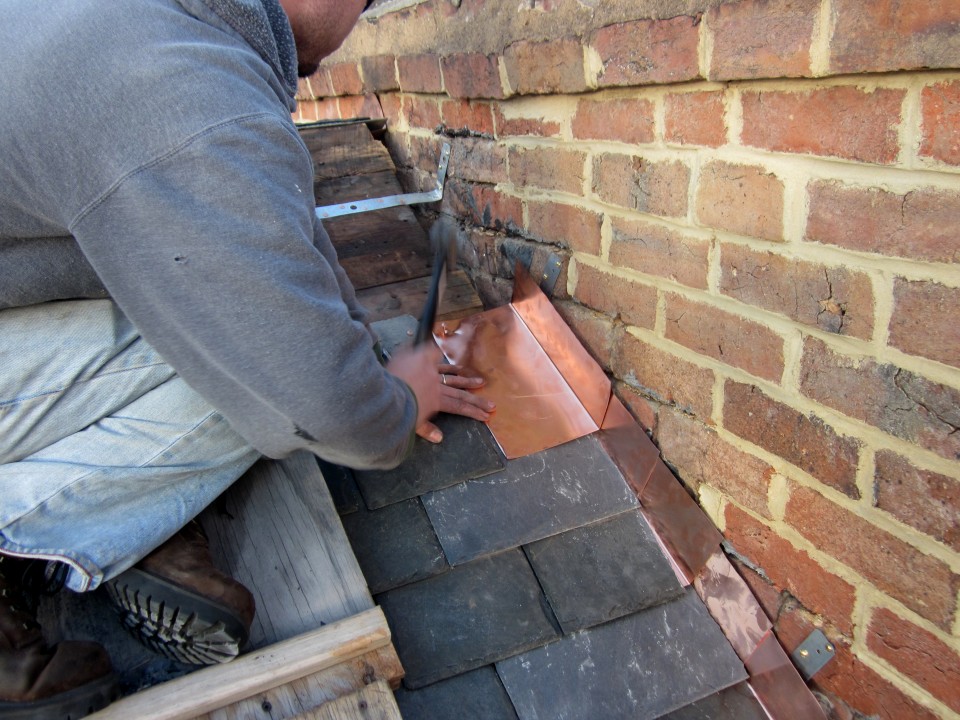 |

Seay’s Chapel Methodist Church is a historic Methodist church located near Palmyra, Fluvanna County, Virginia. It was built between 1893 and 1902, and is a beautiful example of the types of churches we love to help. After a hailstorm destroyed most of the glass on one side of the chapel, we were tasked with matching the glass and repairing the windows.
 |
|
|
After the August 2011 earthquake just a few miles away, this historic church in Mineral, Virginia sustained heavy damage. A complete restoration of the church took place, and we were called upon to provide protection for the stained glass, as well as provide some insulation for the building. We installed perfectly clear 1/4″ tempered glass, which kept the integrity and profile of this beautiful country church. Glass, unlike plastic, never fades or yellows.
|
 |
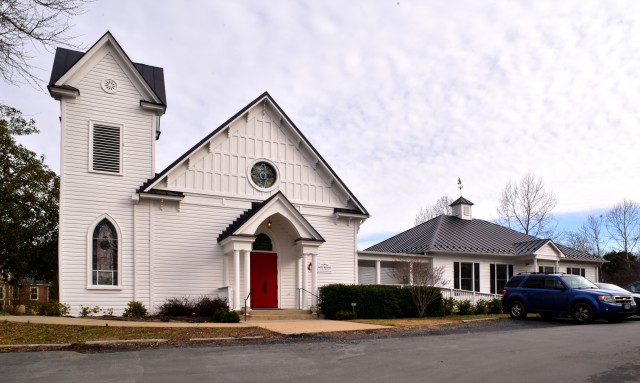 |
This country church had recently been repainted, and they decided to replace their old yellowed plastic coverings with new tempered glass coverings. We removed all the old plastic, cleaned the frames, thoroughly cleaned the glass, and then installed the new protective coverings. The difference was night and day. Now instead of the windows being muted by the foggy plastic, they could once again be brilliant. Parishioners commented that it made the stained glass look new again. The new tempered glass will never fade or yellow. |
||
 |
 |
“The longer we work with Mr. Cain and his studio artisans, the more convinced we are that we employed the best help we could get for the protection of our stained glass windows at Palmyra United Methodist Church. The windows are one of the most valuable parts of our church. They needed to be protected. Mr. Cain suggested to us some options and let us select the method most comfortable to us. Ron Fertile, Co-Chairman of Trustees Palmyra United Methodist Church |
|
“We do not get to know people by their coming to us.
We must go to them to find out what they are like.”
-Goethe

“It’s what’s on the inside that counts.”
 |
 |

This excellent window was commissioned for a historic home in Crewe, Virginia, to complement the finished renovations. Coming from a hill, the briar vine weaves up through the geometric window, giving this piece a light, airy feel. Painted on completely transparent German mouth-blown glass, this window allows the room to remain light while creating a jewel in this home. To see more of this project, please visit our Facebook Page. |

This beautiful window was commissioned for a kitchen in a waterfront home on Lake Monticello. To not obstruct the view outdoors and compliment the colors and beauty of the trees outside, we created a window that used the outside world to enhance its brilliance. As the seasons change, the organic colors will blend with the foliage outside, making new textures and reflections that will be new and exciting every day.
You can see more detailed project photographs on our Facebook Page.
 |
||
| We were commissioned to create a window that brought the incredible palette of Autumn to life in a contemporary window. Using our sculpted solder and flame-worked leaves, we captured the movement of a tree losing its fall leaves.
You can see more detailed progress photos on our Facebook Page. |
||
 |
 |
 |
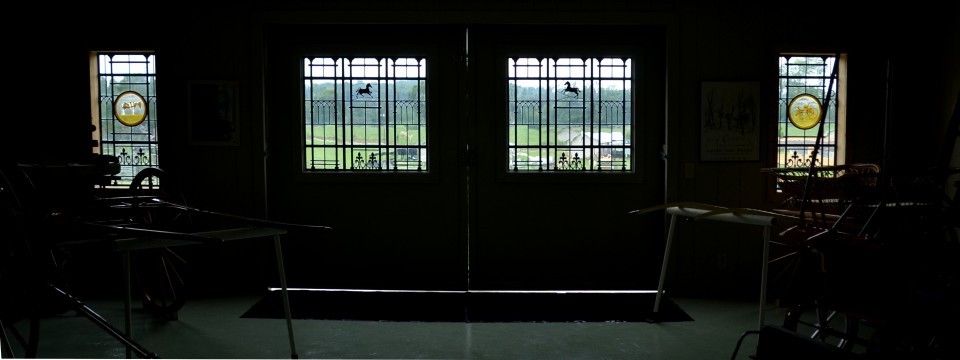 |
|
 |
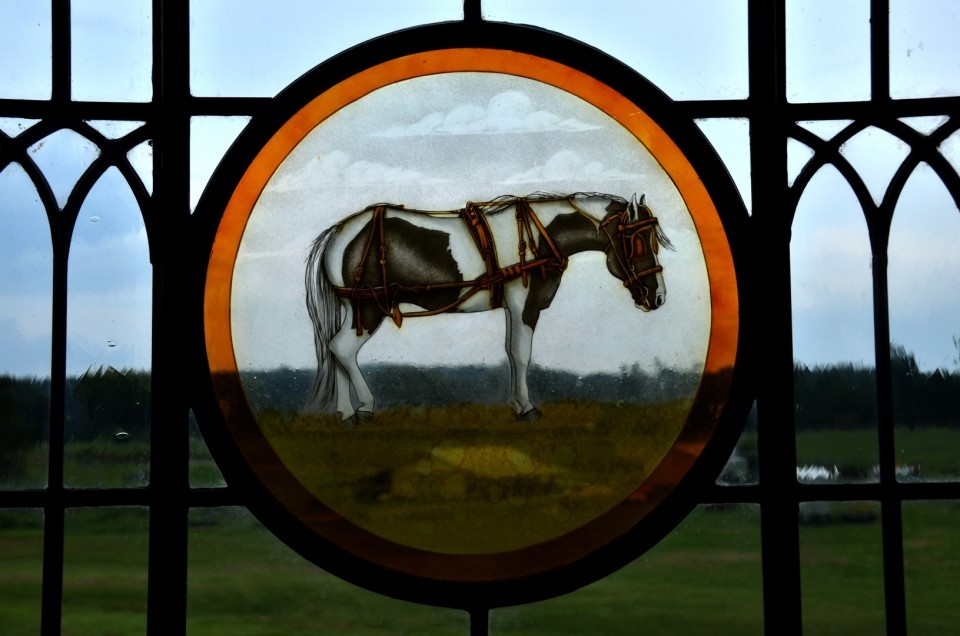 |
 |
 |
This project has so many details tucked away and little hidden gems. The windows were created for an old plantation house near Fork Union, Virginia, in the country outside of Richmond, Virginia. The design was created specifically to match the antique feel and look of much of the farm, and the glass was chosen to match. The owners are equestrians and passionate about old pony carts and carriages. These windows were for the carriage house and rightly showcased the horse and carriage. The lead on these windows is sculpted to be three-dimensional, with sculpted solder horses and fleur de lis as well. The medallions are simple but detailed, one immortalizing a special pony and the other a carriage.

 |
 |
| This window explored our unique style, blending beautiful German reamy glass in the background and flame-sculpted leaves and blossoms to create a floral piece full of color and transparency. Each flower and leaf is three-dimensional, designed by hand over an open flame. The overall effect is a step closer to our goal of realizing the clarity of nature in our glass art.
You can explore this project more in-depth on our Facebook page. . |
 |
 |
| This unique window was for a home that wanted something exceptional. Using our sculpted soldering technique, we build the tree to be three-dimensional, creating bark texture, weaving branches in and out, and doing our best to capture a bare winter tree. The spectacular glass allowed us to capture that sparkle that a late sunset can create and helped bring this project together.
You can explore this project more in-depth on our Facebook page. |
 |
|
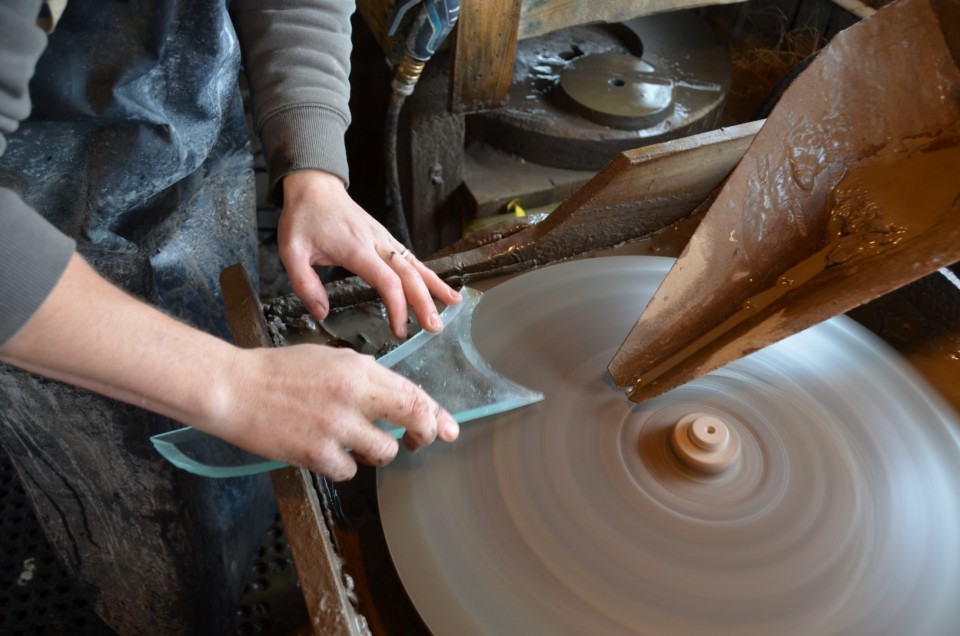 |
We were tasked with replicating the design and brilliance of hand-beveled stained glass windows in a home on Richmond, Virginia’s Monument Avenue, a Historic District. We carefully worked the pattern to fit in the opening and then ground each bevel by hand on our 100-year-old antique Henry Lang beveling machinery. The glow and richness of hand-ground bevels can’t be beaten. The window sparkles with just the barest amount of light hitting it and has an impact both inside and out. You can explore this project more in-depth on our Facebook page. |



This was a private restoration for a couple in the Washington DC area. They had a beautiful painted glass window they had brought back from England, but it had a few broken and missing pieces. We carefully matched the color of the glass, as well as the painting techniques to achieve a perfect match. You’d have to look very carefully to distinguish our work from the original.
You can explore this project more in depth on our Facebook page.
 |
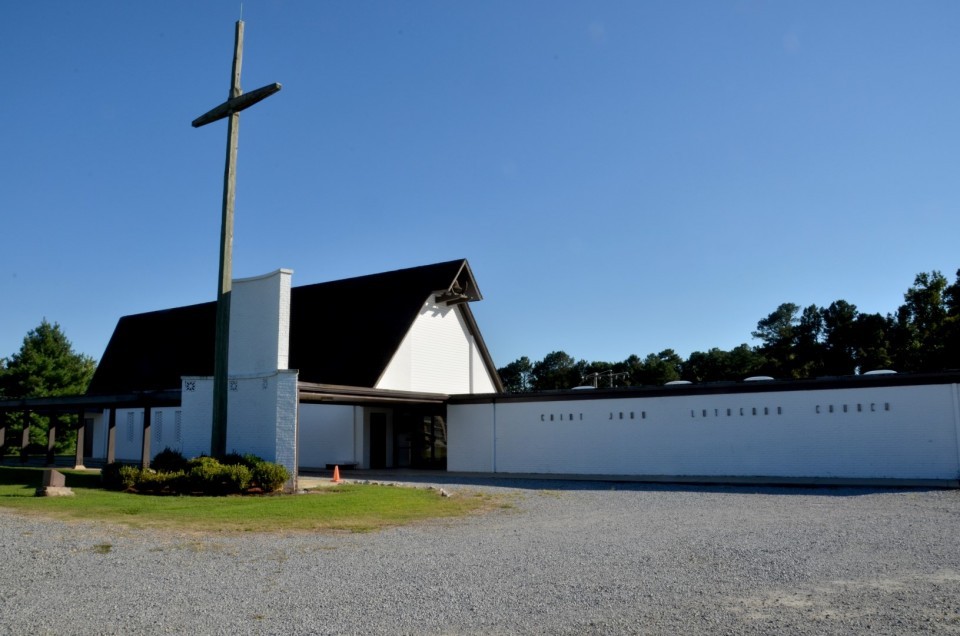 |
| The congregation approached us to enhance the visual impact of a wooden cross behind the altar in their sanctuary. Without lights behind the cross, we developed an idea to use colored mirrors to use the available light above and in front of the cross to make the sunburst design sparkle as you moved throughout the sanctuary.
You can explore this project more in-depth on our Facebook page. |

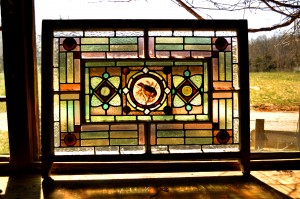

These beautiful windows had been brought to the US from England with a family once a tour was completed. They were absolutely filthy, had many broken or missing pieces, and needed some work to correct bowing and bent lead. We took our time and restored these beauties to their original luster, carefully matching each broken piece, replacing lead where needed, and thoroughly cleaning each window.
You can explore this project more in depth on our Facebook page.
We were contacted for an editorial in the Washington Post where a lady was curious how to light her stained glass window in her apartment using a light-box. We gave our advice, not thinking much of it, and were surprised when we ended up in the paper. Two papers in the same week aren’t bad.
Check out that article Here:
 |
|
 |
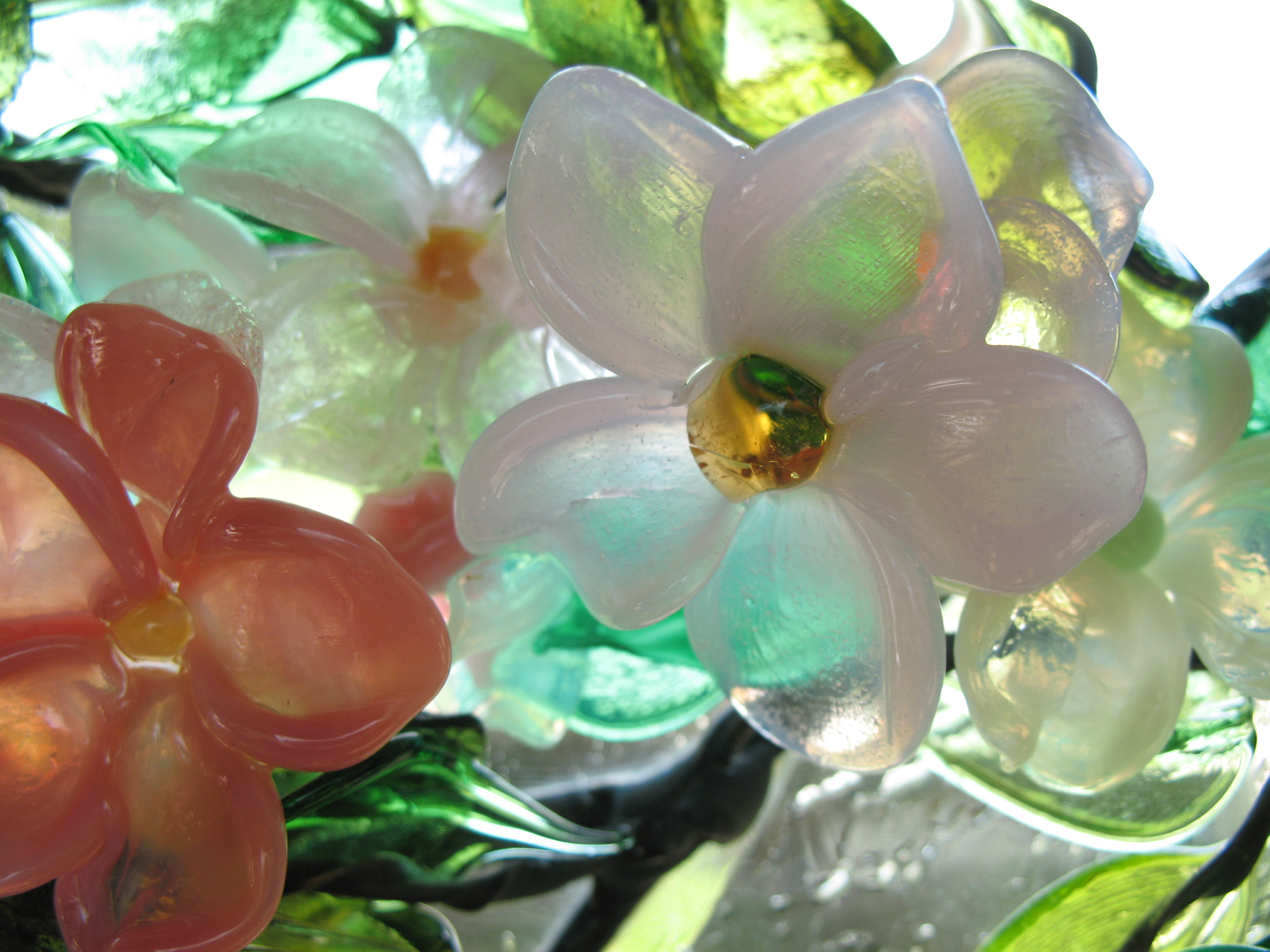 |
| A Contemporary panel we created for Winchester Medical Center’s Cardiac Wing. This panel combined our flameworking, sculpturing, and beveling techniques to create a simple yet elegant piece that compliments the aesthetics of the hospital unit. The apple blossoms on branches played to a local tradition and set on the hand-blown reamy glass sparkled when the light hit the translucent petals.
See more of this project on our Facebook Page. |
|
| This project was years in the making, and an honor to be a part of. We worked with the curators of the museum as well as with the family of Billy Ireland to design a window that reflected his artistry and informed the public of his brilliance. We felt a connection to Billy Ireland; as self taught artists we appreciated his creativity and liveliness. We custom designed the two windows, one for the reading room and one for the foyer of Sullivent Hall, and spent months painting the panels and custom fabricating the steel and bronze frames. This project is one of our finest achievements, and was a pleasure to be a part of. | ||
 |
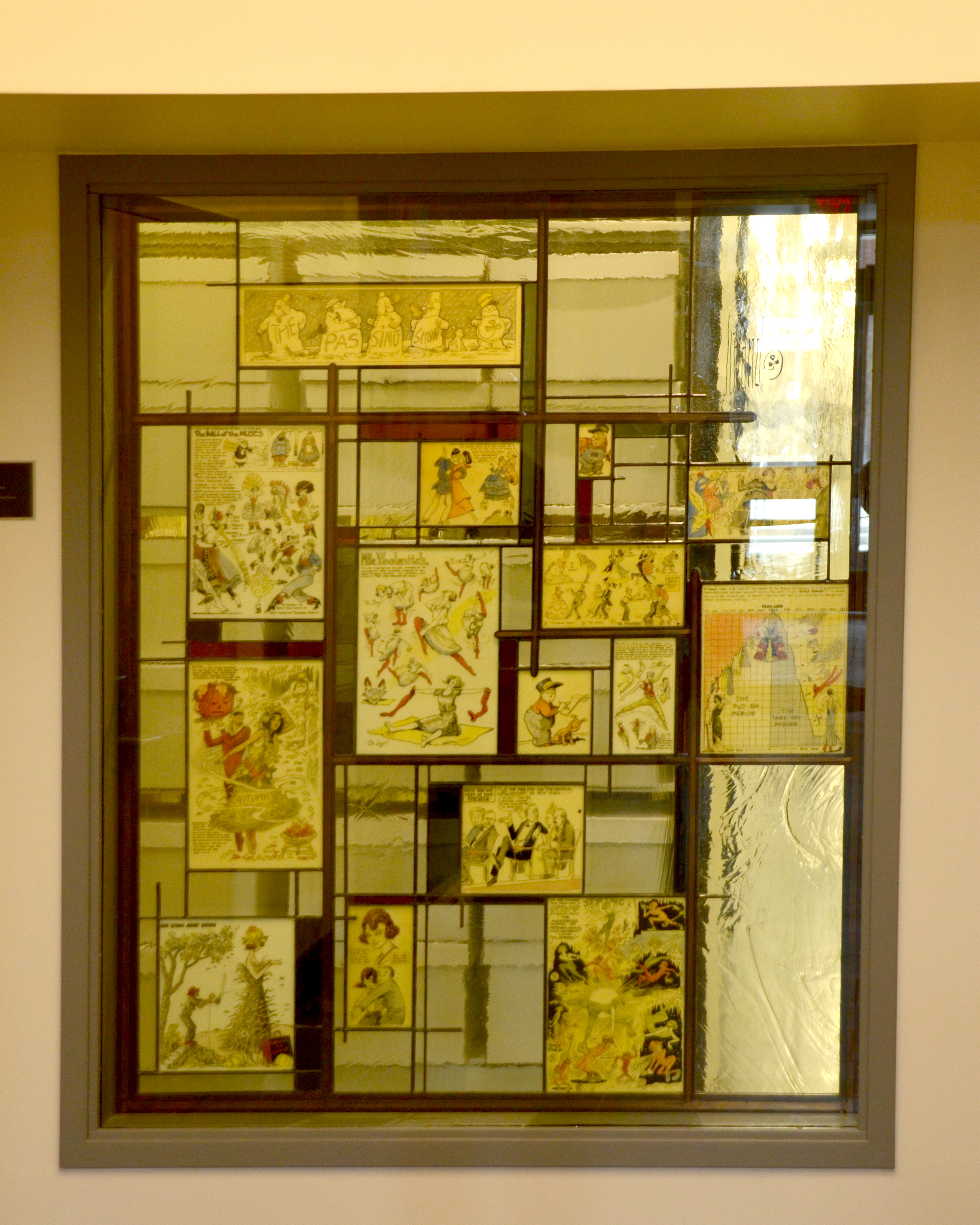
|
|
To see more of our process, please visit our Facebook page

People appreciate that their project is designed specifically for them and will never be reproduced.
New Work
It is the role of the artist to give us something new.
‘New Work’ represents our growth and development beyond traditional art glass.
 |
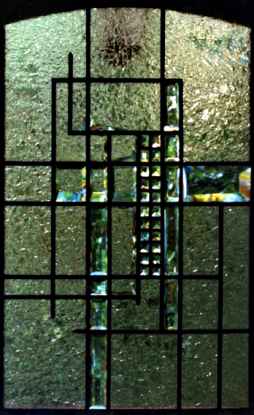 |
| Our windows are asymmetrical, yet balanced. |
Created with different thicknesses and |
 |
 |
|
Incorporating color using fine european hand-blown glass |
|
 |
 |
 |
| Developing our new style, sketch by sketch | ||
 |
 |
 |
|
Free form beveling around sculptured metal creates the illusion of |
||
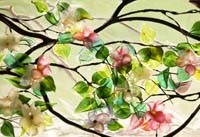 |
 |
|
Working glass over a flame enhances its translucency and frees us from |
|

Tribute window to the work of cartoonist Billy Ireland.
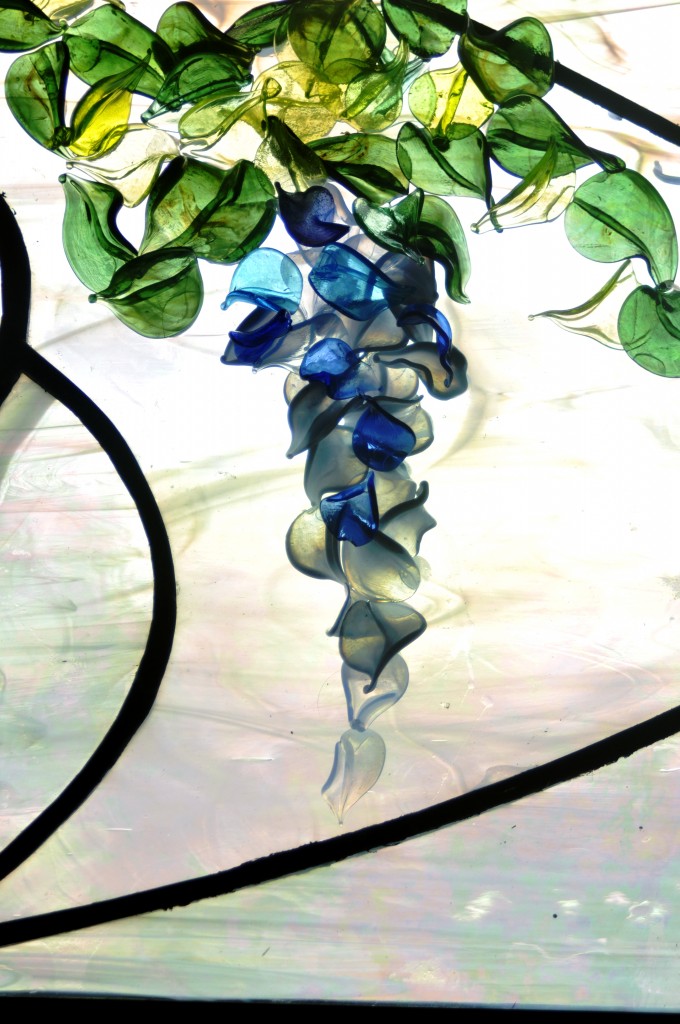 |
This unique window was created for a home outside of Fork Union, and our goal was to accentuate the organic beauty found only in nature. We love how playful Wisteria can be and used the trees around our studio that has it as inspiration. Each leaf and petal was individually worked over an open flame to twist and mold it to the perfect shape. The composition brings out the three-dimensional nature of the glass, while the wispy background glass brings to mind a breeze. We were sad to see this one leave our studio.
To see more detailed progress photos of this project, please visit our Facebook Page. |
 |
|
 |
|
 |
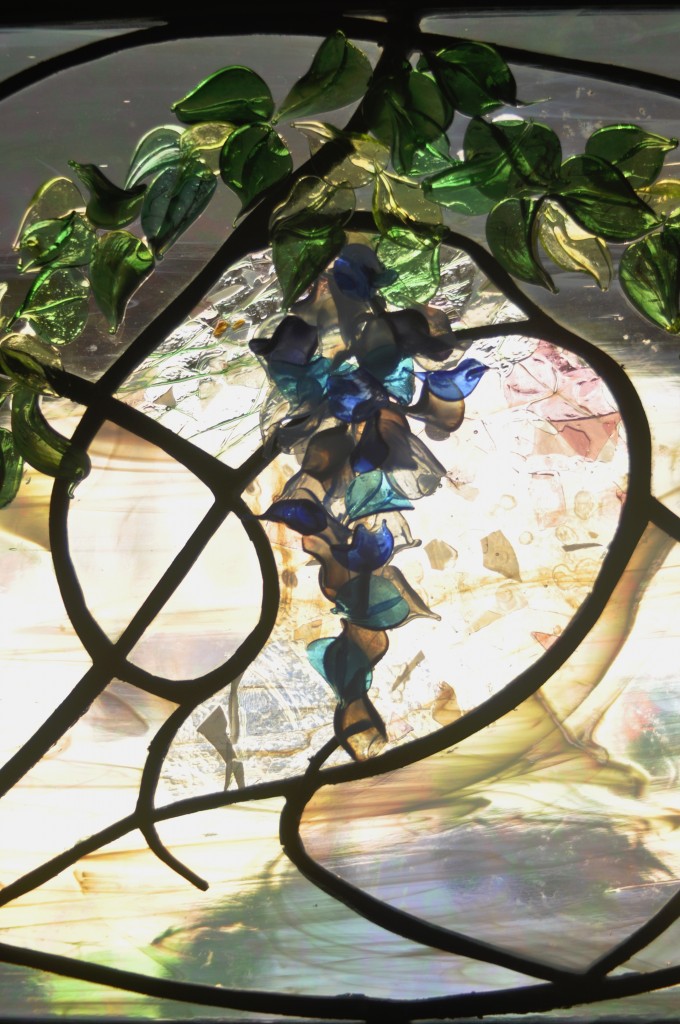 |

When we find a company that makes stained glass, we order their samples and build a rack so we can study them in natural light. We now have 35 racks with hundreds of glass samples. Combining the different characters of the glass as well as their colors for each project individually is an art unto itself.
These samples are useful in communicating with our clients, but to select the final glass we group our projects together and visit the vendors to hand select. Ordering based solely on the samples is very risky.

How colors interact with each other is of great concern. On this very complicated project, we placed the cut pieces on a piece of clear glass that was laid over a pattern. As we progressed, we would hold the “tray” of clear glass over our heads to see how the colors interacted.
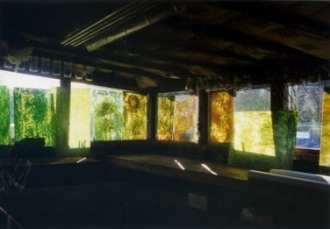 We buy our stained glass in sheets to give us a wide range of color to select from. It takes the eyes at least 20 minutes to absorb color, and so much of our time is spent in selection. It’s not unusual for a few leaves to be cut from a sheet and the remainder placed in our racks.
We buy our stained glass in sheets to give us a wide range of color to select from. It takes the eyes at least 20 minutes to absorb color, and so much of our time is spent in selection. It’s not unusual for a few leaves to be cut from a sheet and the remainder placed in our racks.

Projects evolve. Each day we see them a little differently, constantly trying to imporve what we have created. All of our sketches are done free hand, and with computers and modern technology, we are able to make refinments full scale.

We cut each piece of glass by hand. Sometimes we’ll use a
diamond band saw for sharp inside cuts and a diamond grinder for close fits.
|
Design Service
When working with our clients through the design tage of our art glass windows, we are often asked to help them develop ideas where original hand made objects are considered
Gate and railings surrounding a pool.
Garden Gate
Designing with stone is similar to designing with glass, both in design and color selection. This is a fountain for the end of a pool where color, texture, and design are influenced by materials from different quarries.
Studies for consideration for the above fountain bowl, to be cast in bronze.
Randomized study for stone sidewalk.
Basket weave studies for stone floors.
Wall sculpture
Sculpture studies for bronze and glass
Examples of the diversity of our original art glass designs
|

One of three windows for a living room. We started making the transoms to help control the sunlight in the room. Several years later, we added the bottom area using wavy restoration glass with a beveled glass center. Then the idea evolved to build little glass shelves into the window to hold some of the owners’ blown glass collection.

Stylized Peacock

| A partition separated the power room from the bathroom, where our client wanted the look of a Tiffany wisteria window. The iron gate is part of the window design that evolved as we worked together. This project received both sunlight and artificial light, creating a moody effect throughout the day and evening. |

| Beveling colored glass seemed like the perfect material for this whiplash design. A transom window for a traditional dining room, this piece appears timeless. |

| The curved doors in this cabinet required that we bevel glass that was curved to the exact angle of the doors. By making a wood mold the size and curvature of the door, we could bend the zinc and then traditionally build the window. |


| We stylized these hand beveled windows by using floating caming, zipper cuts and brilliant cutting. Beveling with colored glass gives the one window its unique sparkle, while immaculate bevels define the other. |

| Created for a mud room where the owner wanted privacy but to still be able to see people coming down his driveway. Created by beveling our glue chip glass, clear glass, and a light gold colored glass. |

| Art Deco inspired cabinet doors. These windows are lit from inside the cabinet to help the balance the translucent and opaque glass. Back lighting can be challenging, but often provides a special touch to the space. |
| This beveled glass window was designed and made for the entrance door. Most of our glass beveling is done on 1/4″ or 5/16″ glass, like the windows you see along Monument Avenue in Richmond, VA. We started using 3/8″ glass so our windows would “hold their own” when surrounded by heavy trim molding. The areas that appear dark are emerald green glass. |


Varying the widths on this fan window made it more interesting than the traditional,
even spaced designs of the past. Creating something new that works in a traditional space gives the architecture uniqueness that adds to its value.
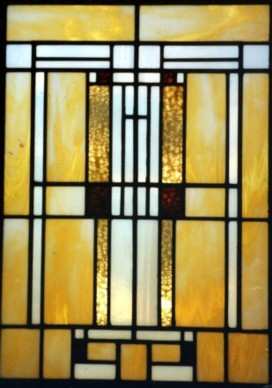
| A Frand Lloyd Wright inspired creation for a front door. |

| We hand beveled 3/8″ thick glass for this entryway so we could achieve a variable bevel that radiates from 1/2″ in the center to 1″ along the outer edges of the window. This gave a lovely movement to the light as it traveled along the bevel, widening and narrowing as one moved to each side. We created this entryway for a home in the Church Hill section of Richmond, Virginia. |
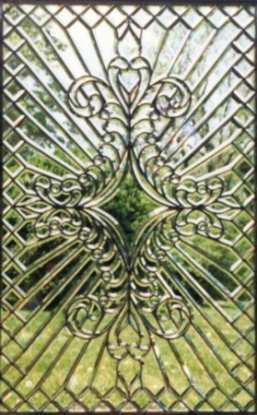

| These are just some of the beveled glass windows we have created using traditional designs in our Historical Collection. Some we make true to the originals, while others we embellish upon with various glass beveling techniques we’ve learned over the years. |

Being surrounded by sunlight helps us to create windows that match the
direction of the light they will receive in their final setting.

We are always looking for new ways to use glass. Painting, acid etching, carving,
beveling, lamp working… combining the materials from different sources and working
them in creative, never ending ways is a wonderful way to spend one’s life.

Sculpting solder with a 250 watt soldering iron. It is amazing how solder will
follow the heat and what one can achieve with patience and practice.

A cozy way to spend the day. Putty drying by the coal stove, radios on;
pushing putty around our stained glass windows can be a nice break from the stress of creativity.

To make our windows weather resistant, we push putty under all the leads.
This also gives the window much of its strength. Final cleaning is time consuming and tedious,
but gives the window a polished, finished look.
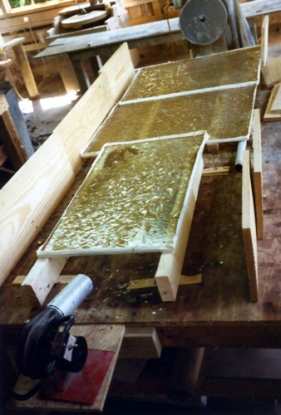
As the glue dries, it grasps the frosted glass and peals it to achieve the chip effect.
We always chip three times as much glass as we need so we can select for the effect we are trying to achieve.
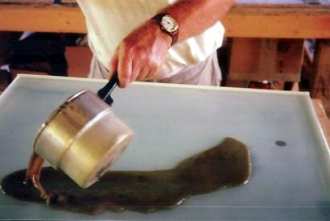
Glue chipping is an old art glass process where one heats aminal glue in a double boiler
and pours in onto a level piece of glass that has been sandblasted. By varying the ratio of glue
to water and how many times we chip the glass we are able to achieve many different textures.

All five of my step children worked in the studio as they were growing up. My father took me to work
with him when I was a child, and as an adult I now consider it one of the most important parts of my life.
This is Matthew, another stepson, helping me cut a pattern.
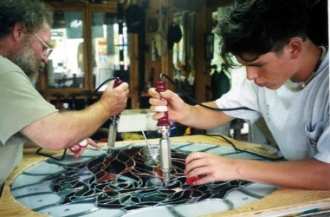
My stepson, Daniel White, has worked with me since he was a teenager. Now at, 30, we work together as
a team, learning from each other as he prepares to make our studio his life’s work. This partnership and
the passing of our art from one generation to another is the pinnacle of my career and gives me great joy.

After transforming our design to a rubber stencil on the glass, we cut the design with an exacto knife.
To achieve the depth and shadows for a landscape design such as this we carved with various mediums from fine to coarse.
Removing the stencil, carving, replacing the stencil, carving… we build on the process.

Sculpting with metal in our windows gives us the ability to create life-like forms like tree and vine motifs,
sometimes adding thorns and branches that protrude beyond the surface of the glass.
Here we use an electric hand-held melting pot to pour the base metal.

Documenting our projects as they develop for our archives and emailing updates to our clients.
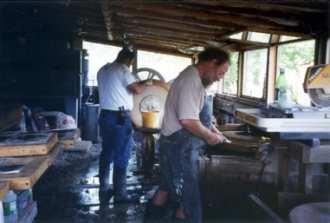
Hand beveling on our 1915 Henry Lang machinery. By holding the glass over rotating iron,
stone, cork, and felt, many small facetes are created to give the bevel its character.

By “waxing” the glass to an area of the studio where the light is the same as where the window will end up
is very important to the success of our projects. We also take into account the presence of trees or sky behind our windows.

Painting on glass is an art unto itself.
This is Missy Scott, one of the most gifted people I have ever worked with.

We created a wall 26′ x 9′ of cut mirror and black glass for a disco around 30 years ago.
You can see the design sketch in the photograph. By leaving the edge clean cut, the revolving
light would travel along the design lines.
 |
 |
 |
 |
 |
This is one of two large windows in which both of the wood frames had to be replaced. We braced the frames and removed each section of stained glass. Each window was carefully restored to revive the original beauty of the artist who created them.

For St. Paul’s we removed all of the yellowing plastic over the stained glass windows and replaced it with clear safety glass that will never fade or yellow. The stained glass windows were created almost 100 years ago by a German studio. Except for the two large windows, the stained glass was in excellent condition due to the level of craftsmanship and being protected from the elements by the plastic coverings.



This Historic Chapel, located on a private estate that dates back to before the Civil War, was being completely restored, and we were called in to repair and renew the artistic vision of the original stained glass windows. There were over 50 separate windows, each in a serious state of disrepair. We repainted each center panel, retouched numerous original pieces, and used UV resin to salvage as many broken pieces as possible. After re-leading, applying reinforcing bars, applying concrete putty, and completely cleaning each window, the final product was absolutely stunning.
To see the whole process unfold, please visit our Facebook page for Before and After photos and explanations.
 |
As churches grow and rebuild, they often take their stained glass windows with them. Here we removed one of the two original windows and restored it by cleaning, removing the bows, and bracing the sections. We then installed it into a light box in the new sanctuary and focused the light on the highlights of the window. |  |
 |
Southern exposure is hard on leaded glass. In this section of the home, the leaded glass was literally falling out of the sashes. We rebuilt the windows using the old glass and new, high quality lead came. |
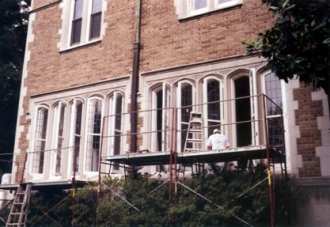 |
 |
The stained glass committee gave us this Icon to reproduce for their new chapel. One does not change an icon. We created the highlights for this window by acid etching European flash glass that is blown clean and dipped into a colored glass. The background was stippled onto a golden piece of glass to look like parchment. Glass jewels were used in the crown, surrounded by small pieces of beveled glass for highlights. The faces and hands we delicately painted throughout four firings in the kilns. |

One of our most spectacular projects is a pair of Rose Windows custom designed and created for the new St. Thomas Aquinas Priory in Charlottesville, Virginia. The Dominican Friars that live at the Priory will pray in the chapel where these windows live five times a day. Each symbol is placed to instruct the faithful and inspire prayer, which hearkens back to the purpose of stained glass in ancient times. Each individual painted piece was fired multiple times and painted using antique processes and techniques. The Dominicans are an old order, and new-style windows woulnd’t suit their new home.

To see more of this post, please visit our Facebook Page.
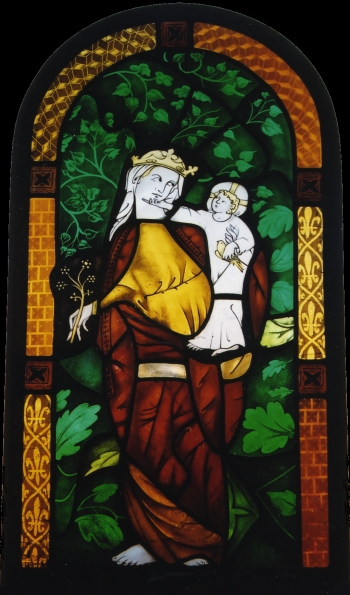 |
 |
| Much of what we have learned comes from studying our historic windows. We were particularly drawn to this section of the 14th-century Eaton Bishop church in Herefordshire, England, because it represented a turning point in religious art. The Virgin no longer seems stiff as in earlier windows and is depicted with a supple, s-shaped form and lively facial expressions.
We created this window to learn from the artists and artisans of this period. This window represents some of our finest work, using the most delicate handblown glass from Europe for color and glass painting for the subtleties of line. The Eaton Bishop study (shown left) is on display in our studio and is used in presentations to church committees considering stained glass for their places of worship. |
|
 |
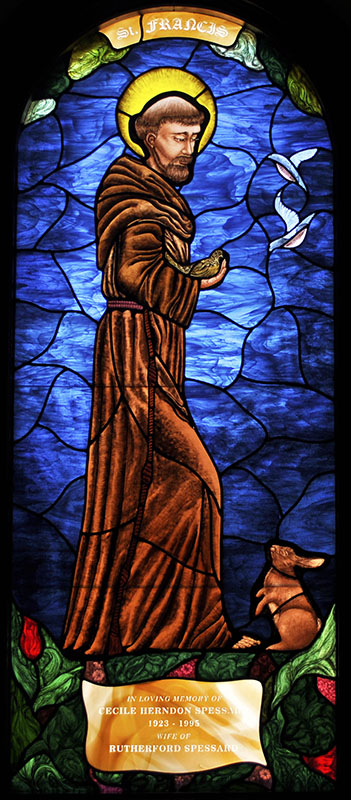 |
A memorial window for one of the members. Our challenge here was the face of St. Francis. Achieving his sweet, gaunt face took many experiments and seven firings. A wild rabbit was a part of the deceased’s daily life.
|
 |
| This photograph shows a third of the windows in this sanctuary. Using a hand-blown translucent glass from West Germany, we could blend the trees and bushes on the exterior into our concept. The striations in the glass give movement to the windows as one walks through the sanctuary. This was my first complete church project over 30 years ago.
A view of the exterior of the church. |
 This window was created to memorialize the minister’s life work at St. John’s Episcopal Church in Columbia, Virginia. I was in charge of installing the window over the back door of the small country church during the service and then taking a back-row seat in the sanctuary. When the service was over, one of the members approached the minister and announced the church had a special birthday gift for him. As the doors opened to reveal the “Guardian Angel” over the entrance doors, I don’t think I have ever seen so many tears, smiles, and joy expressed. One of the most moving experiences of my career
This window was created to memorialize the minister’s life work at St. John’s Episcopal Church in Columbia, Virginia. I was in charge of installing the window over the back door of the small country church during the service and then taking a back-row seat in the sanctuary. When the service was over, one of the members approached the minister and announced the church had a special birthday gift for him. As the doors opened to reveal the “Guardian Angel” over the entrance doors, I don’t think I have ever seen so many tears, smiles, and joy expressed. One of the most moving experiences of my career
 |
A beautiful Gothic church built in 1886 resisted stained glass all those years, feeling it was inappropriate for its all-white color scheme. We started this project by asking if we could place some sheets of glass in their windows. By “living” with stained glass, they began to appreciate the warmth and beauty it contributed to their worship area. Soon there were three donors for memorial windows, each with a desired symbol, scripture, and commemorative plaque for their loved one. |  |